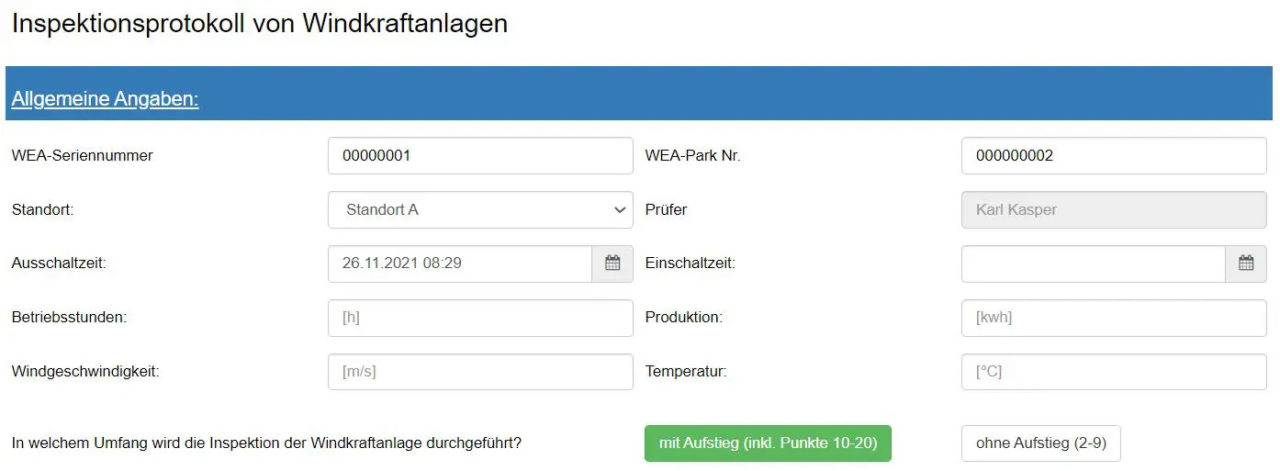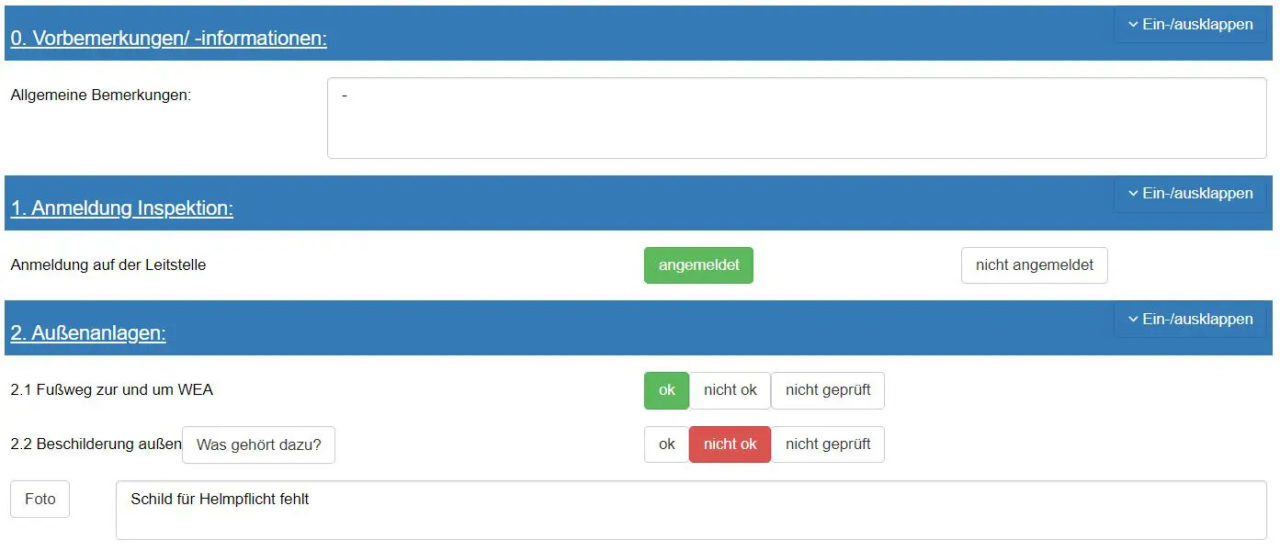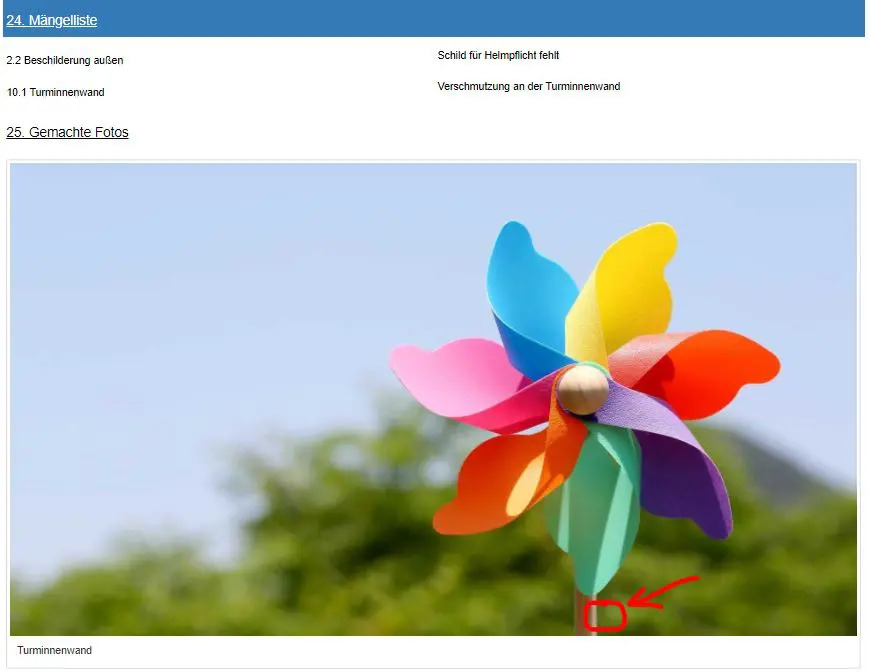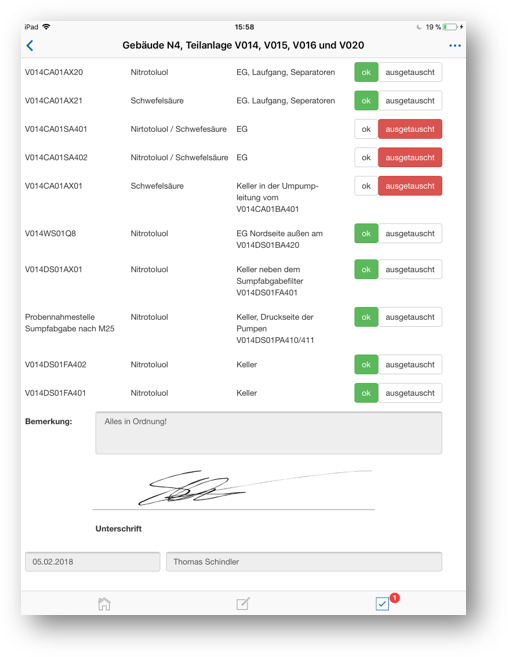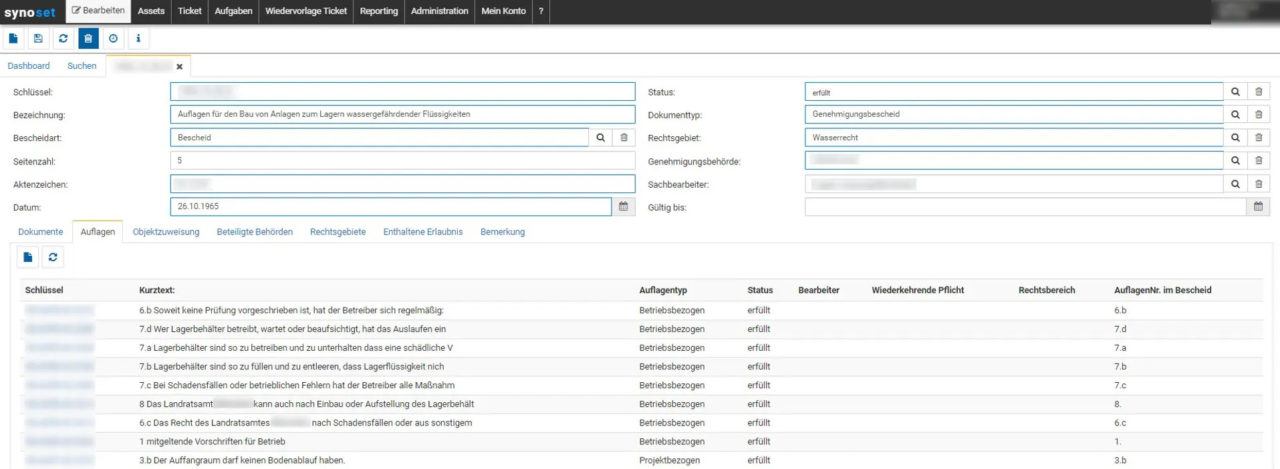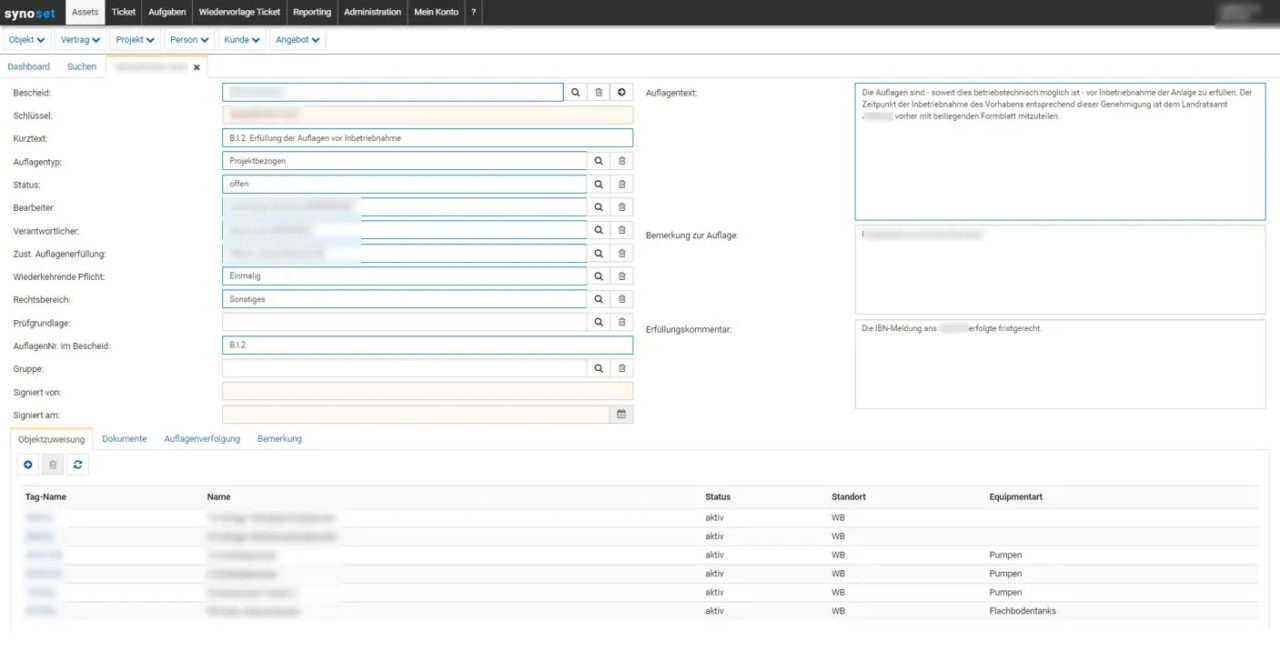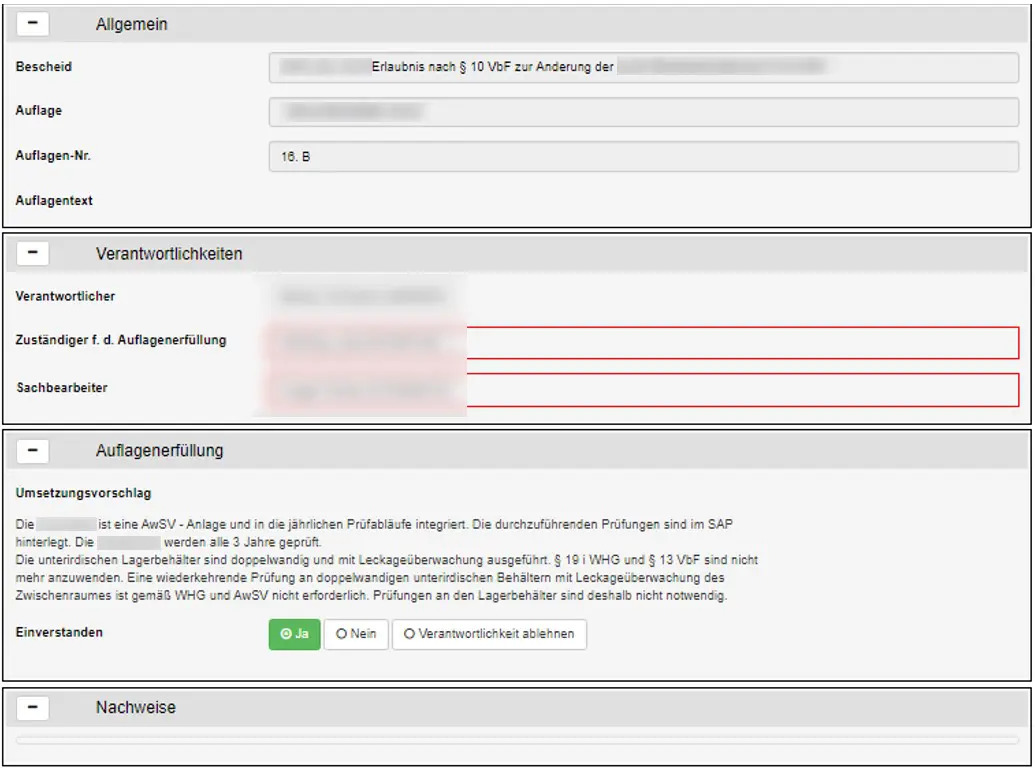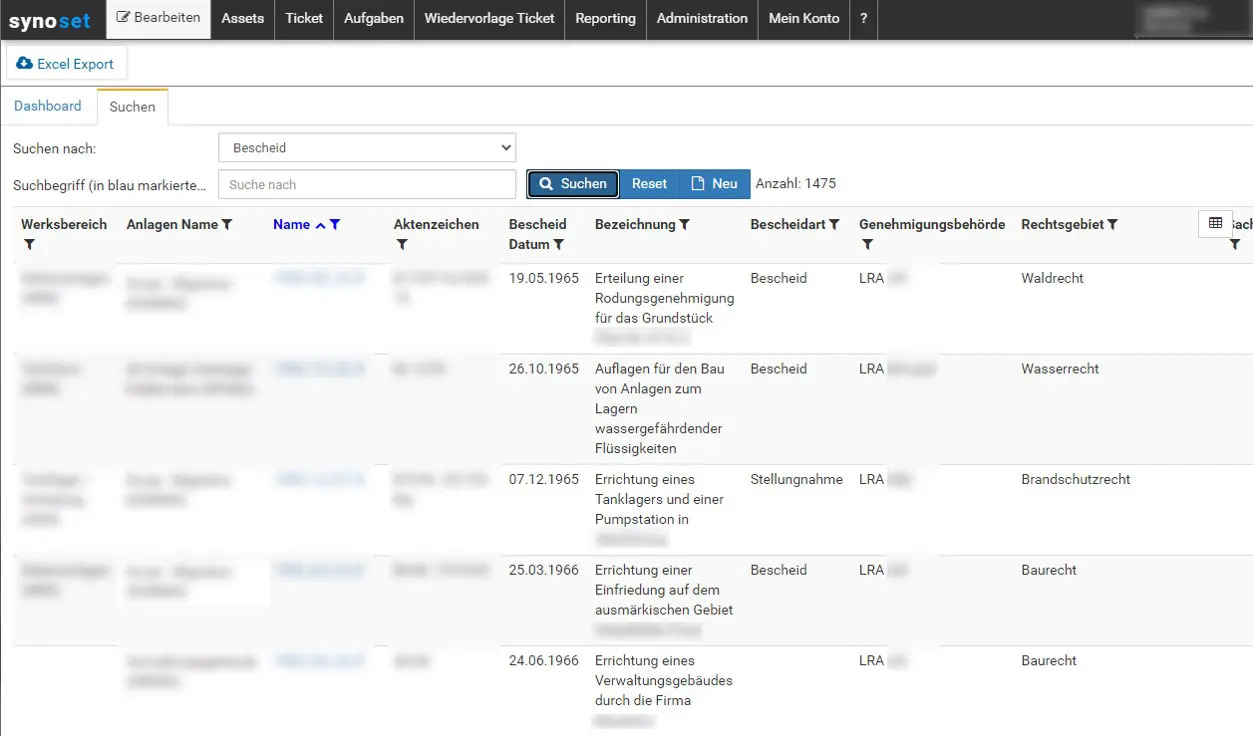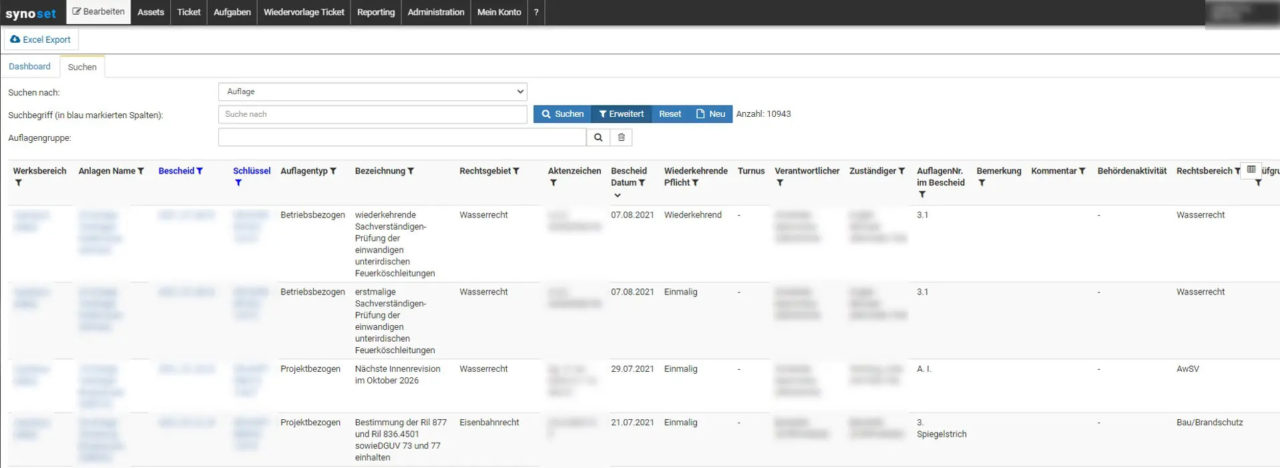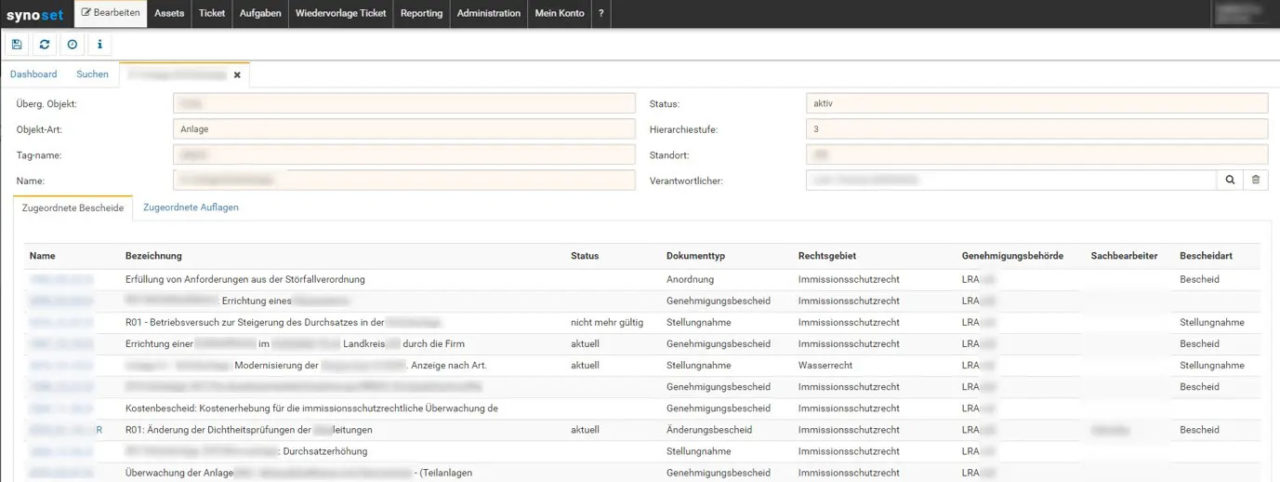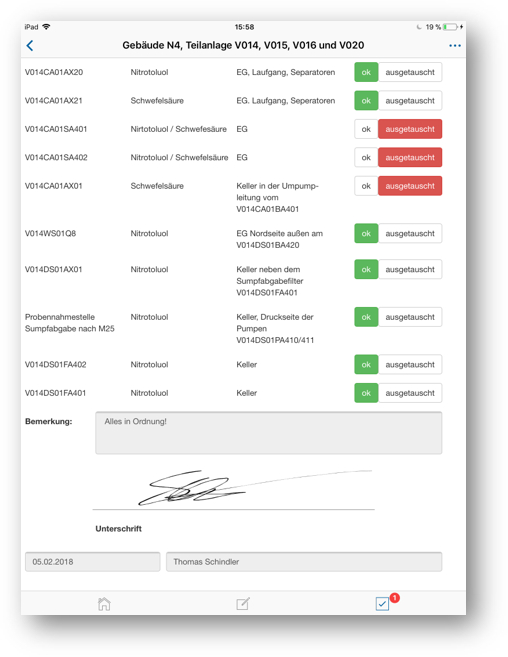Management and maintenance using the example of wind farms
The management of wind farms is very complex. On the one hand, there is the complete asset maintenance with master data management, parcel management, contract management with terms, deadlines and different shareholdings. On the other hand, there is the maintenance process for each individual wind turbine with defects and their rectification. In many places, this is still documented on paper, which ensures neither audit-proof archiving nor efficient forwarding of information.
Management of all asset information

A wide variety of information must be managed for a wind turbine:
- Information on the wind turbine such as company data, contact details of the manufacturer, shareholders, manuals, parts, maintenance cycles, location
- Information on the plot of land on which the wind turbine is located, dimensions and location, owner and lease agreements, sometimes with the involvement of different people
- Contracts for the use of the wind turbine with contractual partners and deadlines
Everything is documented in our software and if input options are missing, either the customer or we can add fields.
When a contract expires, for example, our software automatically reminds you by e-mail.

Complex maintenance process

We can support you throughout the entire maintenance process with our customizable forms and workflows. This starts with the registration at the control center with signature directly in the document, continues with all inspections at the wind turbine and ends with the subsequent logout at the control center. In addition, all inspection points are stored in our solution in an audit-proof manner. If certain points are marked as being out of order, a photo of the problem can be taken directly on site. The problem is then used as a ticket in our system or, for example, an email with a list of defects is sent. The problem-solving process is also documented using checklists so that you always have a history of problems that have occurred and how they were resolved. In addition, it is always possible to see which defects still exist in which wind turbines.
A particularly practical feature for our customers is that many changes to the inspection report can be made without any programming knowledge using our simple drag-and-drop Checkware Designer.

Management of wind farms:
Clear list of defects
All documented defects can be clearly displayed at the end of the checklist, and the documented photos can also be displayed here.
- Processing via “app”, even offline
- Forwarding of defects, e.g. by email or as an additional task in our system
- Storage of the inspection report directly on the asset
Synoset with notification and requirement management
- Status of all conditions and notifications at a glance
- Attachment of documents, links and comments to operating objects (“Digital Twin”)
- Mapping of all inspection processes, i.e. single inspections, cycles and random samples
- Derivation of activities to be carried out via tasks, checklists or tickets
- Verification and documentation of compliance with important requirements
- Integration of service providers if external support is required for inspections
- Audit-proof storage of all information with versioning
Get in touch!
Would you like to know more about our solutions? Then please write us using the contact form. My colleagues and I look forward to exchanging ideas with you.

Dominik Weggler
Head of Sales Germanedge
Managing notices and conditions
Protecting people and the environment
Notices, conditions, planning documents and official correspondence are not an end in themselves. They serve to protect people, companies and the environment. Operating permits for machines, systems and entire plants must be obtained and kept up to date. Environmental regulations, safety requirements and sustainability agreements must also be documented and managed. This often involves regular inspections.
Now there is easy-to-use software to help you with this. As a system for managing documents and regulatory processes, Synoset Notifications and Requirements Management integrates seamlessly into the operational process.
Managing notices and requirements – the burden of responsibility
Every company receives official notices with conditions. The requirements are binding and often have legal consequences. It becomes particularly complicated when dangerous goods are processed, produced or used. Industrial plants often have to comply with several thousand regulations. But normal production facilities and service companies are also subject to safety requirements to protect people and the environment. But how do you monitor compliance with several thousand requirements? For plant managers, the burden of this responsibility is enormous.
Completion in the company

Control the management of notices and conditions as part of the operational process. Synoset’s Notification and Compliance Management supports operational staff in organizing, managing and tracking regulatory notifications and requirements. This allows managers and administration to focus on checking compliance with requirements and the legal conformity of the company.

Simple procedure
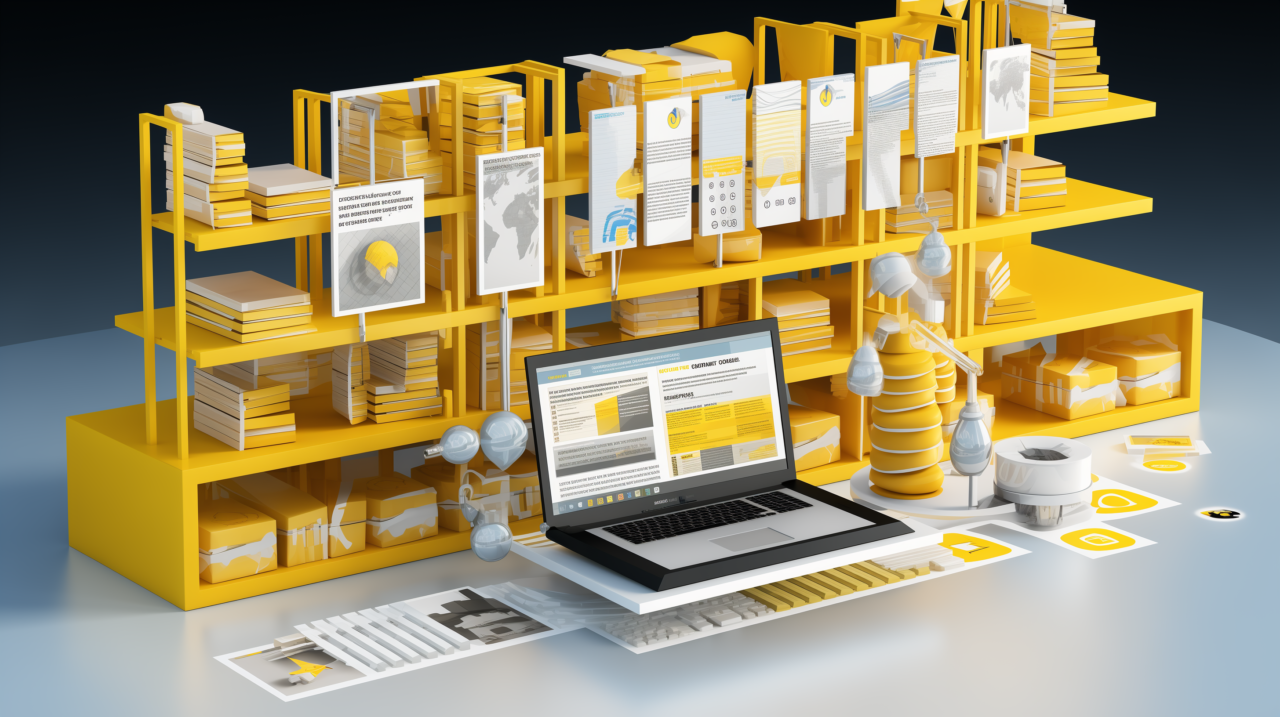
- An authority issues a notice for a new or existing installation and sends it by post, for example.
- The company receives the notification, documents the notification, stores it in the system as a PDF and derives the requirements from it.
- The conditions are processed with the help of checklists and reported back.
- A responsible person/auditor can clearly display the open/completed requirements in the system and call up details.

Convenient linking of notifications and conditions
Notices often contain one or more conditions. These conditions describe a permission, a prohibition or a requirement. Depending on the type of condition, different steps must be taken. In all cases, a responsible person is required to ensure that the conditions are implemented in the company. Deadlines and automatic escalation via emails guarantee prompt processing and avoid penalties.
Professional management of individual conditions
Conditions with can be provided with metadata as required, e.g. text of the condition, condition type, recurring or one-off obligations, condition number in the notice, assignment to objects, comments, etc.
- Recording of recurring obligations
- Proof of the progress and processing status of each condition
- Forwarding of checklists to the person responsible
Approval processes based on the dual control principle ensure that all necessary information is available. This is also possible in several stages for complex requirements. Implementation proposals can be submitted and approved by several people or departments. The resulting measures are implemented, documented and checked for effectiveness. If the measure does not have the expected effect, the process must be started from the beginning and the requirement re-evaluated. In this way, all information is available to those involved in real time, can be processed collaboratively and process reliability is guaranteed throughout.
Once all measures and conditions of a notification have been completed, the notification is automatically set to fulfilled and the responsible persons are informed. This saves time and ensures transparency.
Processing conditions with checklists via cell phone or tablet
Conditions and recurring duties can be transferred to responsible employees for processing via checklists.
- Processing via “app”, also offline.
- Responsible person sends implementation proposals
- Implementation proposals can be confirmed, rejected or forwarded
- Proof of implementation can be attached directly to the checklist
Individual editions can be found quickly
Whether for an audit or a general review, the degree of compliance with a notice is visible at all times in our software with all associated conditions, measures and documents through reports. You can see at a glance which notices have already been processed or which require a higher priority for timely compliance.
Synoset with notice and condition management
- Status of all notifications and conditions at a glance
- Attachment of documents, links and comments to operating objects (“Digital Twin”)
- Mapping of all inspection processes (single inspections, cycles, random samples)
- Routing of activities to be carried out via tasks, checklists or tickets.
- Checking and documenting compliance with important conditions using checklists
- Integration of service providers where external support is required for inspections.
- Audit-proof storage of all information with versioning
Get in touch!
Would you like to know more about our solutions? Then please write us using the contact form. My colleagues and I look forward to exchanging ideas with you.

Dominik Weggler
Head of Sales Germanedge
Why digital running lists actively contribute to improving process reliability in industries
So-called ” running lists” support inspectors during regular inspections – whether in fire protection, maintenance, plant inspection or security. Compared to the paper-based form still used in many places, digital routing lists make a significant contribution to improving safety, especially in complex processes, in critical infrastructures or in extensive areas.

Inspection rounds to check systems, workplaces and buildings are an integral part of occupational and process safety in companies, as they help to ensure the quality of processes and the safety of employees. A common “tool” for monitoring actual conditions and comparing them with target conditions are so-called “running lists”, which inspection personnel use to record data during the rounds. In many companies, they are still provided in paper form.

Advantages of digital running lists

Digital running lists have decisive advantages over their paper-based counterparts: The data is available electronically right from the start and can be stored centrally across all locations. Thanks to the centralized provision, everyone works with the latest version, which is provided via smartphone and saves walking distances. In addition, routing lists react dynamically to entries, and it is also possible to branch out into various subsequent processes: if, for example, the delivery pressure of a pump is lower than specified, a warning message opens immediately upon entry and the inspector can send a message for maintenance or create a task for a specific person. The streamlined and seamless processes therefore consume significantly less working time than the paper form.

No more user errors

Practice has shown that digital running lists counteract typical user errors: individual points cannot be skipped or accidentally forgotten. Data that is not plausible is resubmitted to the auditor. There are no illegible entries, and the inspector always has the current, possibly multilingual checklist to hand thanks to the central document repository. The start and end times of the inspection round are automatically set in the digital checklists, allowing inspection times to be monitored centrally – and this also provides security for the inspector, as they can prove that an error only occurred after their round was completed, for example. Employees can use the digital routing lists regardless of their computer skills, as most are familiar with the use of smartphone apps.

Greater insight through better data

More data is often passed on digitally than with paper-based inspections, be it with image, voice or text information. If the inspector detects a malfunction in a unit, for example, he can also document this with a photo and mark the position using a GPS signal so that maintenance can locate the problem more quickly. It is also possible to create ad-hoc evaluations of inspections and defects. These and similar functions not only improve the quality of inspections. Better data also provides greater insight, and users can make better decisions and deductions.

Optimized for mobile devices

Digital running lists are optimized for mobile devices such as smartphones and tablets: The person carrying out the inspection can complete the digital checklist online or offline and sign it electronically. This means that there is no need to store the data in paper form. When data is entered offline, it is automatically synchronized as soon as a network connection to the central system is available again.

Process security for food, healthcare and CRITIS companies

As digital routing lists are location- and device-independent, their use contributes to process reliability in the food and healthcare sectors as well as in critical infrastructure (CRITIS companies). The inspector does not have to carry their mobile device with them throughout the entire inspection process, but can, for example, interrupt the checklist in zone A and resume it in zone B on another device. This process design makes it possible to avoid cross-contamination caused by a device being carried along, for example.

Connected worker platform as a central communication hub

Everything that is entered in the digital running list can be synchronized directly with other Connected Worker applications such as the FINITO digital shift log. There, an event – such as the pump’s delivery pressure being too low – is immediately visible to all affected employees, maintenance can take immediate action and management staff are also immediately informed.

Your added value
- Master data transfer. Labor saving, as master data such as inspector, date, time etc. is automatically transferred from other systems; support selection fields.
- Task management. As part of task planning, digital running lists can be triggered and assigned to individual inspectors, planning of intervals and deadlines possible.
- Evaluations and reporting. Data can be comprehensively evaluated and summarized in reports. Storage in a central database. Interfaces to other systems.
- Platform-independent. The digital running lists work on any IT device and with any platform – be it iOS, Windows or Android. They can be accessed as an app or via Internet Explorer.
- Integrated. The digital running lists can be used as a stand-alone solution. Integration with other IT systems, in particular the FINITO shift book, is also possible.
- Layout in your own corporate design. The layout of the digital routing lists can be designed according to your own CD guidelines.
Changes are continuously updated and the data is archived in a central database in an audit-proof manner. The data can be exported in various formats, for example to Excel, for evaluation. Connection to common master data and reporting systems is possible.
Get in touch!
Would you like to know more about our solutions? Then please write us using the contact form. My colleagues and I look forward to exchanging ideas with you.

Dominik Weggler
Head of Sales Germanedge
How to improve security and quality in CRITIS infrastructures
Today more than ever, the security and quality of public and CRITIS infrastructures are being put to the test: be it the expansion and conversion of electricity, gas and hydrogen grids, the sustainable modernization of transport infrastructure, the circular economy, etc. – the challenges of ecological and digital transformation must be taken into account everywhere. Transparency about your own offerings, processes and employees and precise knowledge of the current situation are prerequisites for setting the right course for long-term success.

Many companies and institutions are faced with the question: How do I collect and collate data and how do I then process it as effectively and sustainably as possible? Regularly recurring audits on paper have proven to be a stumbling block: The documents are usually poorly legible, sometimes missing information, or they are outdated; some quality and safety checks are not carried out at all. Sometimes the paper documents lie on the inspector’s desk and are not processed for weeks – no one has an overview of when and whether the deviation from the target has even been rectified.

Digital system to ensure the quality of personnel

But there is another way, as the use case of an Austrian company shows: This company has established a digital system to ensure the quality of staff in its bus and rail transport operations. The system checks, for example, whether toilets and passenger areas are clean, whether ticket machines are working, whether gearboxes are regularly serviced and whether drivers are careful and friendly on the road. The list of possible safety and quality checks is long, and the number of vehicles and employees to be checked is in the hundreds in the extensive region.

Carry out tests on the move via cell phone

The Austrian company has several groups of inspectors carry out the safety and quality checks in public transport. They automatically receive the checks in the form of digital checklists for specific occupational groups in their mobile apps. This allows them to carry out inspections on the move using their cell phones as part of their workflow – without wasting time and without extra paper-based processes. This leads to greater acceptance and increases operational safety on the road. The digital inspections offer a wide range of functions such as plausibility and completeness checks, integration of photos, digital signatures, etc.

Automated processes with follow-up of measures

Depending on their qualifications, the employees of Austrian transport companies are checked in different cycles for compliance with quality and safety regulations that are important for transport operations. Electronic workflows are used to forward the recorded data to the relevant departments, which can now check, approve, save, evaluate and store it in an audit-proof manner. In the event of an inspection of the transport companies by supervisory authorities, it can now be proven at any time that compliance with the necessary standards is being monitored. The digital system can also be used to initiate improvement measures and track their implementation. The bottom line is that this leads to automation of the entire inspection process and serves to continuously improve safety and quality in public transport.

Your added value
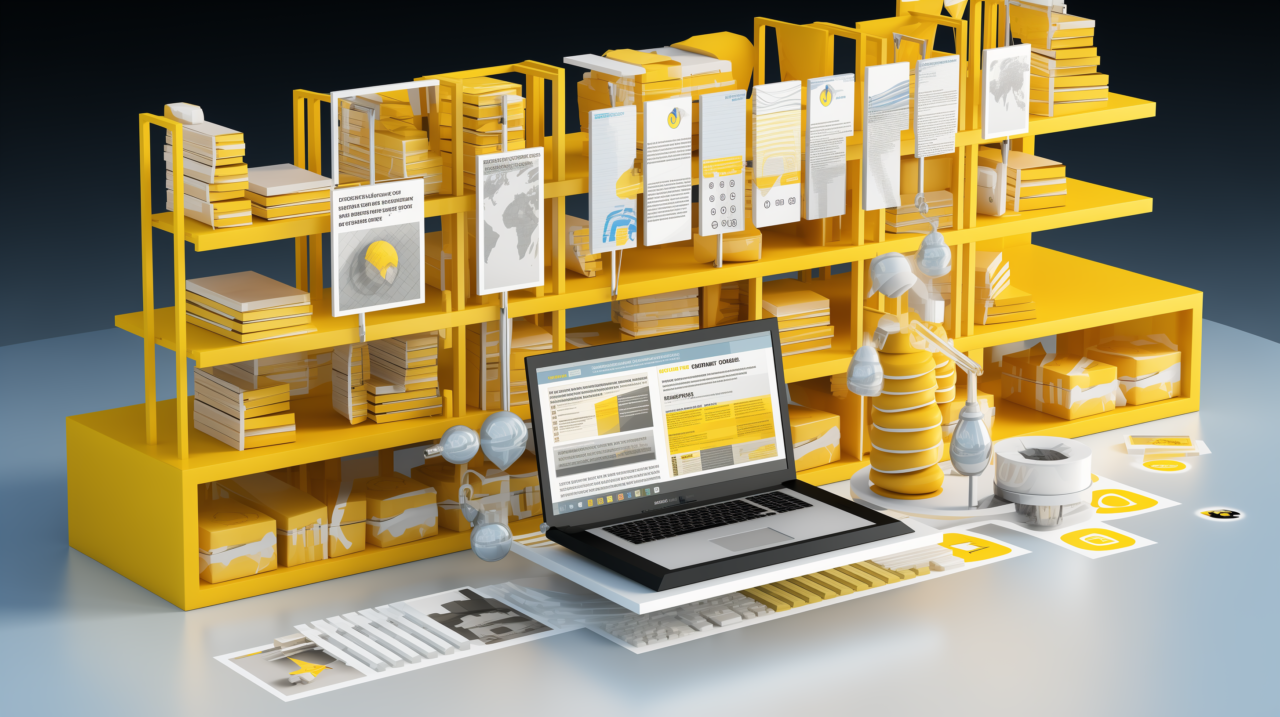
- Comprehensive provision. Digital checklists are created in a standardized form, managed centrally and made available to inspectors. They can be adapted to new requirements or legal changes at any time with just a few clicks.
- End-to-end digital process. Reduced workload and a more secure process at the same time. Documents are found more quickly and the quality is higher. Deadline monitoring in the background.
- Continuous improvement process. No need for a complex ticket program, improvement measures are initiated in the system, deadlines are set, response times are monitored


- Interactive forms. Adapt dynamically to all types of stationary and mobile IT devices and can be filled out using a keyboard, pen or touchpad. Platform-independent.
- Electronic signatures. Signature pads or touchscreens for integrating the examiner’s name. This also enables audit-proof filing without additional paper printouts. Time and cost savings
- Multilingualism. Checklists can be created in several languages in parallel, the language selection is made by the user.
- Audit-proof archiving and documentation. Changes are continuously updated and the data is archived in a central database in an audit-proof manner. The data can be exported in various formats, for example to Excel, for evaluation. Connection to common master data and reporting systems possible.

Get in touch!
Would you like to know more about our solutions? Then please write us using the contact form. My colleagues and I look forward to exchanging ideas with you.

Dominik Weggler
Head of Sales Germanedge
Occupational safety through fire protection: how digital checklists make inspections more efficient
Occupational safety is a broad field that also includes all aspects of operational fire protection. Experience has shown that regular inspections of fire protection regulations and systems increase safety. What is often lacking on the operational side, however, is company-wide controlling of individual measures. Digital checklists and project management tools can help here.
Preventive fire protection includes, in particular, the regular inspection of extinguishing systems – which is usually carried out using checklists. If these are made of paper, trouble is inevitable: The data recorded is not very detailed, potentially incomplete or illegible and, above all, it is not immediately available to other employees/departments. This delays subsequent processes such as repair and maintenance work or the KPI-based, commercial evaluation of the systems. What’s more: Paper-based checklists do not always reflect the latest legal and technical status.
Digital from the start
In order to ensure the functionality of the extinguishing systems – and therefore the safety of employees – it has proven to be a good idea to record the data digitally from the outset: instead of using a clipboard, paper and pen, the person responsible fills in the current, system-specific checklist using a finger gesture or pen on a standard mobile device. Regular inspections in particular can be carried out efficiently, completely and error-free with the help of electronic checklists.
Instructions and logic check
Digital checklists guide even inexperienced inspectors safely through the process. They guarantee that nothing is forgotten, no point is skipped and no typing errors are made. This is because a logic check is carried out in the background, any incorrect entries are displayed and can be checked again. Handwritten additions can be converted into text using OCR text recognition. Photos are also integrated, as is the verifier’s signature at the end.
Multi-stage electronic workflows
At the end of the process, data is not only available in digital form, it can also be processed immediately by other systems. With the help of multi-level, electronic workflows, the recorded data is forwarded to the responsible employees/departments – also across branches and companies – who check, approve, save, store in an audit-proof manner, evaluate and summarize it in meaningful reports in the desired corporate design as required.
Your added value

- Completeness: Individual checkpoints are not skipped or inadvertently forgotten
- Clarity: There are no illegible entries as with handwritten checklists
- Efficiency: The information does not have to be entered again on the computer afterwards, but is immediately available in the database after synchronization
- Plausibility: Data that is not plausible is resubmitted to the inspector
- Up-to-dateness: inspectors always have the latest version of the checklist to hand, as these are maintained centrally in Checkware
- Multilingualism: The checklists can be maintained in several languages, which is important for a globally distributed service organization.

Get in touch!
Would you like to know more about our solutions? Then please write us using the contact form. My colleagues and I look forward to exchanging ideas with you.

Dominik Weggler
Head of Sales Germanedge
Work approvals with digital checklists: transparent mapping and documentation of multi-stage processes
In order to protect employees or external companies during hazardous work in the company, many things need to be considered, such as risk assessments, deadlines, protective measures, rules, responsible persons and approval processes. Occupational safety officers are faced with the challenge of maintaining an overview and stringently following defined processes. With digital checklists that support multi-stage processes, this is child’s play.

Permits to work are a structuring element of approval and work clearance processes that are required by law for potentially hazardous work. They describe the work to be carried out, where and when it is to be carried out, by whom it is to be carried out and what precautions are to be taken. Only when the preparations have been properly completed and checked and signed by the responsible persons are release and permission slips issued. Work approvals are therefore an important element of occupational safety, involving a large number of people and areas.

Digital checklists versus digital approval systems

It is well known that software tools can support complex processes such as the work approvals described above. Digital checklists have proven to be a neutral, less performance-hungry and intuitive tool for easily distributing work approvals to users, as they are flexible to use.
Digital checklists can be easily distributed to internal and external employees via the (mobile) internet and used by them via a web browser or smartphone app. Once a checklist has been completed, the subsequent approval processes are simple and automated via an email workflow. The person responsible for an area only sees the part of the checklist for which they are responsible and approves “their” items with a digital signature. This takes the complexity out of the process for the individual person.

Map the entire approval process with digital checklists

However, digital checklists are not just a simple way of recording data. The checklist software is also able to map the multi-stage approval and release process for hazardous work 1:1. Functions such as handwritten signatures, reminders by email or app and automatic escalations are supported. This also ensures that once processes have been defined, they are worked through step by step and no step is skipped.

How do checklists support the process?

If work approvals are implemented as digital checklists, there are advantages for everyone involved: health and safety officers have an overview of ongoing approval procedures, deadlines, protective measures, etc. via their dashboard. The digital checklists can be used to record hazards, integrate risk assessments and create, check and document protective measures. Responsible persons are defined, reminder e-mails are sent and deadlines are planned. Digital work approvals also ensure reliable and uniform documentation, thereby increasing legal certainty.

Simple administration

With the checklist designer, once trained users can create the checklists themselves without any programming knowledge – the various control element templates are simply dragged and dropped into the document. New and modified checklists are published immediately and are then available to all users. In the app version, the checklists can also be used offline. The recorded information is then synchronized and stored centrally.

Your added value

- More simplicity. Automated processes, also multi-level, target group-oriented. Area managers only have to process what falls within their area of responsibility, thus removing complexity from the process.
- Better overview. Via their dashboard, all managers have access to the current release certificate processes and can view the status at any time.
- Greater process reliability. Multi-stage processes are supported, step-by-step implementation, all persons/departments involved are reliably involved.
- Greater legal certainty. Clear proof of who documented what and when, less scope for manipulation, time savings for employees.
- More flexibility. Access to the solution via browser and link, view a wide range of information from any location or make adjustments to checklists.

Get in touch!
Would you like to know more about our solutions? Then please write us using the contact form. My colleagues and I look forward to exchanging ideas with you.

Dominik Weggler
Head of Sales Germanedge
Safety for people, the environment and operations
How digital checklists support the loading of dangerous goods
The transportation of hazardous goods is subject to strict regulations in Germany, regardless of which route is used. To ensure that nothing happens en route, the utmost care must be taken during loading. A specialized checklist software provides optimum support for shippers in this process. They are workflow-driven, ensure completeness, accuracy and plausibility of the data and make reporting and documentation transparent and (audit-)secure.
How checklists support the loading of dangerous goods

Meticulous preparation is the be-all and end-all when transporting dangerous goods – and this begins with the loading of the dangerous goods. Using checklists, shippers check in detail and carefully whether all regulations relating to the filling systems, transport units, drivers and vehicles are complied with. Unfortunately, paper-based work increases the risk of incorrect information, omissions or illegibility, which can have serious consequences. If a malfunction or accident occurs during transportation, this can be fatal. Digital checklists, which the shipper fills out on their tablet or smartphone, consistently counteract possible sources of error, as the use case of a refinery shows.

The right checklist for the hazardous substance to be loaded

Every year, the company carries out thousands of shipments of hazardous materials, many of them by rail. It uses its own digital checklist for each individual hazardous substance. This is maintained centrally and distributed to the shippers via an email link or app. It is therefore always up to date with the latest legal requirements. In this way, the shipper always has the correct checklist in the currently valid version to hand on site. And therefore does not run the risk of carrying out his inspection on an outdated version. This also saves him time and walking if he does not have a particular checklist with him and would otherwise have to walk back to get it or request it by phone.

Is the freight wagon number correct?

In the past, the hectic daily routine sometimes led to incorrect entries or individual points being forgotten, so plausibility checks were linked to individual fields in the digital checklist. For example, when entering the 12-digit UIC freight wagon number, the self-check digit is automatically calculated according to the Luhn algorithm. If this is incorrect, the shipper is notified of the error.
Mandatory fields and automatically pre-filled fields such as date, time and name of the shipper prevent gaps and save time when completing the form. They also limit the scope for manipulation. A digital checklist can only be completed when all items have been filled in or ticked off. The document must also be signed. If the shipper notices something that they would like to document, they can take a photo with their smartphone and integrate it into the checklist.

Fill in online and offline

The digital checklists not only ensure maximum accuracy during the loading process, they also support and optimize upstream and downstream processes. For example, they eliminate the need for printers, ink and paper and minimize travel times and maintenance costs. And since many employees today have a smartphone or tablet anyway, no major investment is required on the hardware side.
The digital checklists can be completed both online and offline, and synchronization takes place automatically as soon as (mobile) internet is available again. Once completed, they are automatically forwarded so that the entire scanning process is no longer necessary, for example. The completed checklists are stored centrally and the information is transparent for all authorized employees. They can be found quickly using the search function. All data is stored in an audit-proof manner, providing clear evidence of who documented what and when.

Avoid fines through legal certainty

Overall, digital checklists therefore improve the safety of people and the environment in the company, resulting in fewer claims and fines from the authorities and fewer internal problems, as documents are filled out correctly more often.

Your added value

- More security when entering data. Plausibility checks, e.g. for tank wagon numbers, fewer incorrect entries, documentation with pictures on site, check for completeness
- Greater legal certainty. Clear proof of who documented what and when, less scope for manipulation, also saves time for employees
- More time for value-adding activities. Automatic mail forwarding or filing in the document management system, so that the entire scanning process is no longer necessary and saving is also automated.
- More efficiency. Eliminate printer ink and paper waste, minimize travel times, minimize printer maintenance, find information quickly using the search function and soon also very easily using the KWG number
- More flexibility. Access the solution via browser and link, view a wide range of information from any location or make adjustments to checklists.

Get in touch!
Would you like to know more about our solutions? Then please write us using the contact form. My colleagues and I look forward to exchanging ideas with you.

Dominik Weggler
Head of Sales Germanedge
Global shift operation control
When it comes to digitalizing the value chain, speed is of the essence – for example when it comes to the global rollout of digital shift books. Our best-practice example of a successful and rapid rollout strategy shows how standardization can reduce costs, make data transparent and processes better and more secure.

Production sites are individual in terms of processes, work specifications, shift systems, etc. In order to map their peculiarities as far as possible, many companies roll out their digital shift books plant by plant – and in such a way that the shift book is tailored precisely to the needs of the location. Although this ensures a high level of acceptance among the workforce, it costs a huge amount of time and money in terms of IT strategy and makes rollouts slow and sometimes impossible, especially for larger companies. What’s more, the shift books are heterogeneous and have different versions.

Success through speed

Best practice examples show that a switch to a standardization strategy with globally uniform, digital shift books is particularly recommended for globally active groups with more than ten production sites. This not only reduces rollout costs, but also allows you to achieve your strategic goals earlier: internal communication is improved and the same applies to global processes. Information on shift events is available centrally and can be viewed by all authorized persons worldwide. The effort involved in searching for information is reduced, shift handovers are faster, safer and, if necessary, contactless. You and your employees are able to make better and, above all, faster decisions.

Global shift operation control and documentation

A high degree of standardization enables uniform implementation as well as a cost-effective and fast rollout. Not only will new sites be connected, but sites with older versions will also be brought into line with the current Group standard. As soon as all sites are using the standardized digital shift books, global shift operation control and worldwide documentation of shift events, including corresponding reports, will be possible.

What you should take your time for: the standardization phase

The first step is to define a group-wide standard that all companies can agree on. Experience has shown that this phase takes the longest, but it is the basis for later rapid success – end-to-end digitalization of the entire value chain. The standard relates to functionality and integration into processes and with other systems. For example, shift events can be enriched with real-time operating data and maintenance messages can be exchanged with SAP PM.

Configuration, roll-out and go-live

In further project phases, the roll-out per location is carried out up to the go-live. The first step is to set up the standardized digital shift books for each production site as a test environment – this usually only takes a few hours per site. This step is important so that the sites can quickly check whether the test system meets their expectations. If not, corrections are integrated into the standard. Before the sites go live, employees are trained on the new system using a training platform.

Your added value

- Offene Systemstandards: Technologisch für die Anforderungen der Zukunft gewappnet.
-
Hohe Usability: Mitarbeiter haben auch beim Einsatz an wechselnden Standorten stets dasselbe System.
-
Schneller und kostengünstiger Roll-out: Zeit- und Kostenersparnis
-
Zentrales Projektteam: Ansprechpartner für alle Standorte
-
Selbstermächtigung: Self-Service-Funktionalitäten integrieren, damit Betriebe auch selbst Anpassungen vornehmen können, ohne jedes Mal ein Ticket zu öffnen.
-
Mehrsprachigkeit. Gesamtes System im Standard in mehreren Sprachen verfügbar.

Get in touch!
Would you like to know more about our solutions? Then please write us using the contact form. My colleagues and I look forward to exchanging ideas with you.

Dominik Weggler
Head of Sales Germanedge
Efficient shift and personnel scheduling for industry
It is said that it is easier to look after a bag of fleas than to create a shift plan that makes everyone happy. Especially as, in addition to the wishes of the employees, there are also many legal requirements and special regulations regarding shift systems, working hours, vacation, sickness and overtime to consider. Efficient shift and personnel scheduling for industry ensures that shift staffing matches the planned workload as closely as possible and leads to the desired production result – with the greatest possible flexibility for employees. Ideally, the solution is even part of the Connected Worker platform.
Many hands tug at a shift planner: employees need a day off, want to swap shifts, work part-time or decide whether they want to be paid overtime. Shift and operations managers want to have an optimal, appropriately qualified shift roster based on the amount of work that needs to be done. The HR department keeps an eye on working hours and legal requirements, and financial accounting needs to know how much pay it needs to pay out.
Personnel scheduling in five-shift operation

Anyone who wants to stay relaxed here uses the Emplovis IT system – similar to a power plant in NRW. In the five-shift operation there, around 40 employees generate process steam and electricity for around 12,000 employees 365 days a year, 24 hours a day. The shift supervisors create shift schedules at the touch of a button, carry out personnel deployment planning for the shift groups and record absences and overtime with a variety of different absence and overtime types with just a few clicks. In addition, authorized persons can see at a glance who has worked when and for how long and who can still be assigned – based on the existing qualifications and the requirements of the workplace. The system also informs employees when their qualifications expire and need to be retrained.

Minimizing errors in planning

Emplovis is fundamentally flexible and adapts to customer requirements. Color-coded layouts and self-explanatory pictograms support the use of the system so that even less IT-savvy employees can quickly get to grips with it. Interfaces, for example to IT and HR systems such as SAP, enable the automated forwarding of data on worklists, technical workstations or wage information.

Freely selectable views

The shift and personnel deployment planner allows you to see at a glance which employee is assigned to which shift: Views can be defined via a dashboard so that they correspond to the personal preferences of the viewer. Shifts, vacations, absences and absences are color-coded. Using filters such as period, organizational unit, employee, team, absence, weekly, monthly and annual evaluations (balance overviews) can be created for each employee or shift and printed out if required. The number of employees present and absent per day and line is visible via a grouping to check the required number of receipts.

Access for you from anywhere

The solution can be accessed from anywhere via a web browser, so employees can view their personal shift plan from home and are also informed of last-minute changes, for example if a colleague falls ill. Changes that affect an employee can also be sent to them automatically by e-mail so that they do not always have to actively check.

Just one arrow or a whole quiver?

The power plant operations team records around 15,000 shift events per year in digital operating logs, some of which are forwarded to maintenance as repair reports via SAP. The shift personnel always have an overview of all relevant shift events on a display board in the control room. Recurring processes are supported with digital checklists. This provides shift workers with an optimized display of data.
In addition to Emplovis, the power plant also uses other applications from the Connected Worker platform, including Finito 4 and Checkware. The platform creates a whole marketplace of possibilities for companies to achieve better internal communication, more process reliability when recording information, less effort when searching for information and faster shift handovers. Find out more, we will be happy to advise you!

Shift and personnel scheduling: Your added value

- More flexibility, regardless of the shift plan model, all shift types, shift patterns and shift groups.
- Fewer errors. Support for shift planning, for example through field notes, comparison with legal rules defined in the background, vacation days already taken, etc.
- Time saving. with regard to intuitive management, in combination with the shift book all data is immediately available at a glance
Fewer organizational problems and costs due to incorrect planning - Web-based access. Can be used from anywhere via web application, alternatively data can be sent directly as a PDF and can therefore always be viewed
- Qualifications and skills. Automatic check of whether an employee is allowed to work at a workplace based on their qualifications

Use case: Staff scheduling for a 7×24 power plant operation with shift documentation and digital checklists
Henkel, Philipp Poetzsch, HSI Industrial Solutions – Utilities Steam and Power Generation
The power plant operation of Henkel AG & Co. KGaA at the Düsseldorf site is a VKW operation in 24/7 mode. Shift schedules, personnel deployment planning, the recording of absences and overtime with a large number of different absence and overtime types are mapped in the Emplovis personnel module. The operations team also records important shift events in digital shift logs and thus always has an overview of all relevant shift events on a display board in the control center. Recurring processes are supported with digital checklists. This provides shift workers with an environment that is optimized for their specific needs.
Get in touch!
Would you like to know more about our solutions? Then please write us using the contact form. My colleagues and I look forward to exchanging ideas with you.

Dominik Weggler
Head of Sales Germanedge
Integrated maintenance
Part of the business
Modern maintenance serves to protect people, systems and the environment. However, operation and maintenance are often separated from each other and block each other.
Now there is easy-to-use software that combines operation with maintenance.
Three areas of maintenance are supported
Consistent solution
Of course, a quick repair is of little use if, for example, lubrication schedules are not adhered to. Expensive damage occurs again and again due to a lack of maintenance and inspection. This is why maintenance must provide comprehensive support for operations with maintenance, inspection and repairs. Storing all processes in the machine file creates empirical values for runtime forecasts and the option to optimize costs with dynamic repair and maintenance cycles.
Wartung

Maintaining the target condition
Prevent foreseeable damage caused by creeping fault patterns before it is too late. Regular maintenance tasks increase the running performance of your systems. Maintenance tasks such as lubrication schedules should therefore be integrated into the operating process in appropriate cycles. In the Finito shift book, for example, recurring tasks with checklists can be transferred to the shift operation. Such tasks can be assigned to persons, groups of persons or specific shifts. By evaluating the checklists, it is possible to check at any time whether maintenance processes have been carried out according to plan.

Monitoring

Inspection of the current status
Inspection tasks can be created once for a specific date, recurring or ad hoc in our software and assigned to an employee. Recurring tasks also often refer to information from third-party systems, such as the number of machine hours, production runs or are activated by value overruns. This supports preventive inspection and reduces costs.

Repair

Restoring the target state
Sometimes a repair is unavoidable. In this case, internal or external repair units are often called in. Orders have to be placed. Spare parts are often procured externally.
Finito and Checkware make this easy. A message can be sent directly to a downstream MRO system via a button in the shift book.

Example: Communication between shift book and SAP Plant Maintenance

- Maintenance notifications to SAP are created from the shift book
- Clarification checklists can precede the notification
- Repair and maintenance orders from the SAP system can be
- be queried in Finito / Checkware by the shift employees -> no more queries.
- Received by employees in the Checkware Maintenance app and even processed offline
- can be called up from SAP

Modern maintenance is integrated into operations
Übersichtlich

Our software provides maintenance staff with a clear overview of all planned maintenance work at all times. He selects the work to be carried out and is supported in the process on site by accompanying checklists. This guides the employee through the maintenance process with the help of instructions, images, videos, plausibility checks, mandatory fields, geotagging, signatures and much more.
The employee can provide additional information at any time during this process. A popular method is, for example, adding images of damage with additional information such as a drawing directly in the image and automatically forwarding it to a responsible employee or a third-party system such as SAP PM. This saves time and ensures that all colleagues are on the same page. If the employee carrying out a task is unable to complete it, it can be automatically forwarded and, in the case of important tasks, escalated.

Modern

To guarantee speed and process reliability, it is possible to generate a maintenance message or display the tasks to be performed by scanning a QR/barcode or RFID tag directly on the machine. All process information is stored in the system in an audit-proof manner. Regardless of whether this is the employee carrying out the task or the start and end time of the activity. All information can be stored automatically if required. This saves time and provides additional transparency.

Linked to the machine file

As all events on the machine are saved, information is easy to find. For example, the machine file can display all changes and maintenance activities from previous years or list all spare parts and tools in use or under repair. With clear reports, correlations are recognizable and derivations for continuous improvement are possible.
Design documents, calibration protocols, lubrication plans, operating instructions and driving instructions are also saved on the machine object. This automatically creates a comprehensive plant logbook or machine file with complete documentation of all events and documents. The worker in front of the machine has access to the information, as does the operations manager who wants to find out about the maintenance status of his systems, for example.

Extended areas of application

Once in operation, further use cases can be seamlessly integrated into the platform. Typical processes include security checks, cleaning activities, building inspections and much more. Thanks to its flexibility and customizability, our software solution can be easily adapted to a wide range of processes and creates added value in a variety of business processes.

Added value

- Increase in OEE by 2% through more efficient maintenance
- Reduction of input errors by approx. 70% through plausibility checks
- Faster evaluation by approx. 90% thanks to digital recording
- 100% elimination of transfer times to third-party systems
- 70% less work carried out incorrectly due to employee guidance
- 90% less work not carried out thanks to automatic reminders to deputies/supervisors

Advantages

- Reduction of downtimes through statistics on faults and downtimes as well as quick access to solutions for similar or identical faults in the past
- Reduction of unplanned malfunctions by identifying and processing systematic faults (preventive maintenance)
- Saves time when preparing maintenance by displaying the necessary data directly at the machine location.
- Fewer errors thanks to up-to-date documents on inspections, maintenance and repairs
- Faster problem solving thanks to comprehensive machine file with documentation of the latest changes
- Legal certainty with regard to certifications with expiration dates and reminders

Use case: Maintenance shift operation with checklists for troubleshooting and recurring maintenance activities
PC Electric, Christoph Greiner, Head of Electrical Systems Engineering Department
PCE specializes in the production of CEE industrial plugs and sockets, earthing contact plugs and sockets and has particular expertise in plant engineering. PCE’s maintenance department works in 5x24h shifts. Faults are recorded as shift events using checklists. The machine is clearly identified using a QR code, the damage is documented with a photo and the incident is forwarded to the relevant unit for further processing. In addition, recurring inspection and maintenance activities are triggered fully automatically with a total of around 250 checklists and processed on site using mobile devices. Optionally, content can be forwarded to QA for permanent resolution. A total of approx. 10,000 events are handled annually.
Get in touch!
Would you like to know more about our solutions? Then please write us using the contact form. My colleagues and I look forward to exchanging ideas with you.

Dominik Weggler
Head of Sales Germanedge


